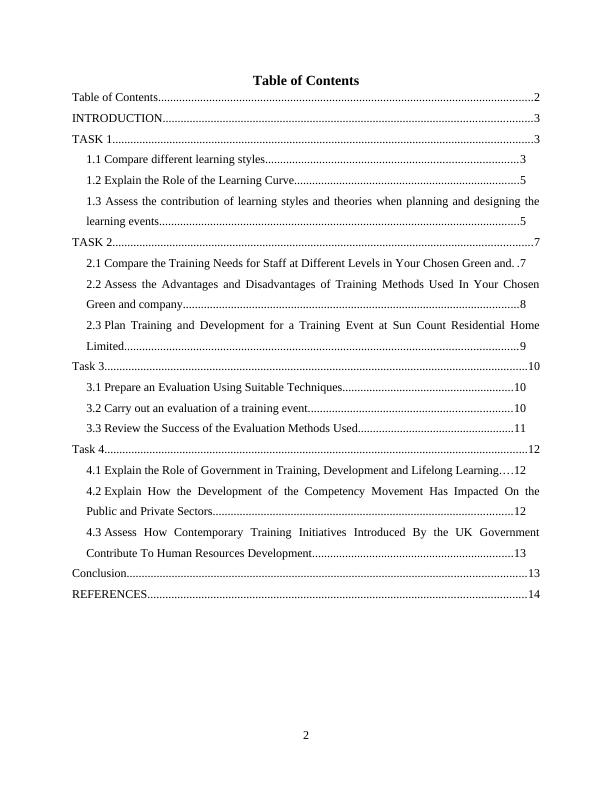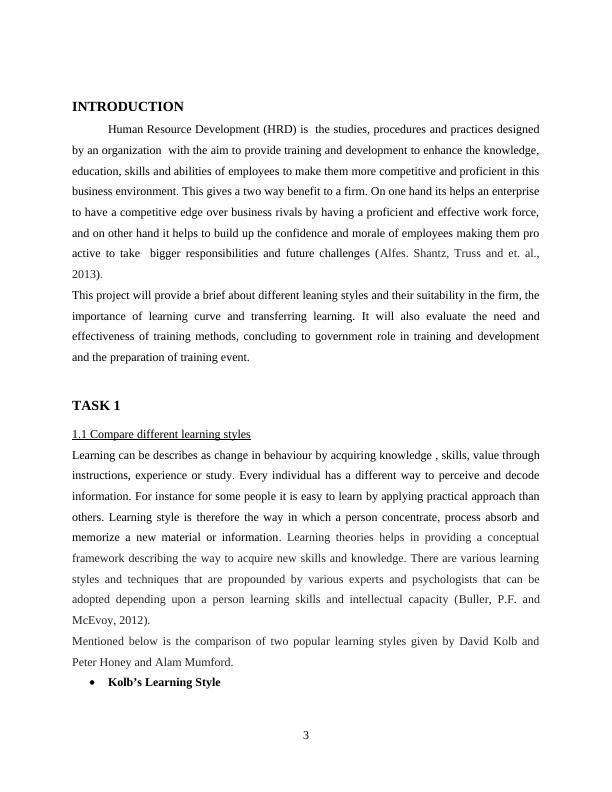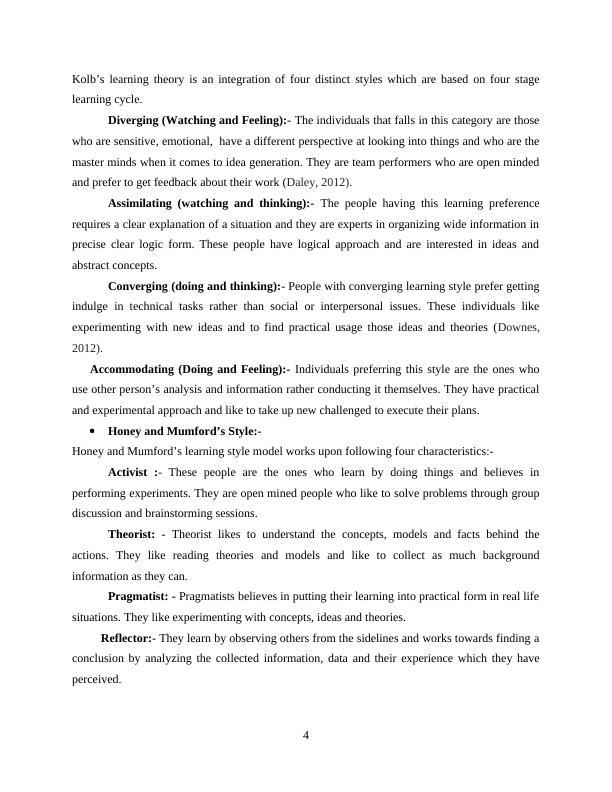Human Resource Development: Learning Styles, Learning Curve, Training Needs, Training Methods
Added on 2023-03-20
15 Pages4399 Words67 Views
Human Resource
Development
1
Development
1

Table of Contents
Table of Contents.............................................................................................................................2
INTRODUCTION...........................................................................................................................3
TASK 1............................................................................................................................................3
1.1 Compare different learning styles....................................................................................3
1.2 Explain the Role of the Learning Curve...........................................................................5
1.3 Assess the contribution of learning styles and theories when planning and designing the
learning events........................................................................................................................5
TASK 2............................................................................................................................................7
2.1 Compare the Training Needs for Staff at Different Levels in Your Chosen Green and. .7
2.2 Assess the Advantages and Disadvantages of Training Methods Used In Your Chosen
Green and company................................................................................................................8
2.3 Plan Training and Development for a Training Event at Sun Count Residential Home
Limited...................................................................................................................................9
Task 3.............................................................................................................................................10
3.1 Prepare an Evaluation Using Suitable Techniques.........................................................10
3.2 Carry out an evaluation of a training event....................................................................10
3.3 Review the Success of the Evaluation Methods Used....................................................11
Task 4.............................................................................................................................................12
4.1 Explain the Role of Government in Training, Development and Lifelong Learning....12
4.2 Explain How the Development of the Competency Movement Has Impacted On the
Public and Private Sectors....................................................................................................12
4.3 Assess How Contemporary Training Initiatives Introduced By the UK Government
Contribute To Human Resources Development...................................................................13
Conclusion.....................................................................................................................................13
REFERENCES..............................................................................................................................14
2
Table of Contents.............................................................................................................................2
INTRODUCTION...........................................................................................................................3
TASK 1............................................................................................................................................3
1.1 Compare different learning styles....................................................................................3
1.2 Explain the Role of the Learning Curve...........................................................................5
1.3 Assess the contribution of learning styles and theories when planning and designing the
learning events........................................................................................................................5
TASK 2............................................................................................................................................7
2.1 Compare the Training Needs for Staff at Different Levels in Your Chosen Green and. .7
2.2 Assess the Advantages and Disadvantages of Training Methods Used In Your Chosen
Green and company................................................................................................................8
2.3 Plan Training and Development for a Training Event at Sun Count Residential Home
Limited...................................................................................................................................9
Task 3.............................................................................................................................................10
3.1 Prepare an Evaluation Using Suitable Techniques.........................................................10
3.2 Carry out an evaluation of a training event....................................................................10
3.3 Review the Success of the Evaluation Methods Used....................................................11
Task 4.............................................................................................................................................12
4.1 Explain the Role of Government in Training, Development and Lifelong Learning....12
4.2 Explain How the Development of the Competency Movement Has Impacted On the
Public and Private Sectors....................................................................................................12
4.3 Assess How Contemporary Training Initiatives Introduced By the UK Government
Contribute To Human Resources Development...................................................................13
Conclusion.....................................................................................................................................13
REFERENCES..............................................................................................................................14
2

INTRODUCTION
Human Resource Development (HRD) is the studies, procedures and practices designed
by an organization with the aim to provide training and development to enhance the knowledge,
education, skills and abilities of employees to make them more competitive and proficient in this
business environment. This gives a two way benefit to a firm. On one hand its helps an enterprise
to have a competitive edge over business rivals by having a proficient and effective work force,
and on other hand it helps to build up the confidence and morale of employees making them pro
active to take bigger responsibilities and future challenges (Alfes. Shantz, Truss and et. al.,
2013).
This project will provide a brief about different leaning styles and their suitability in the firm, the
importance of learning curve and transferring learning. It will also evaluate the need and
effectiveness of training methods, concluding to government role in training and development
and the preparation of training event.
TASK 1
1.1 Compare different learning styles
Learning can be describes as change in behaviour by acquiring knowledge , skills, value through
instructions, experience or study. Every individual has a different way to perceive and decode
information. For instance for some people it is easy to learn by applying practical approach than
others. Learning style is therefore the way in which a person concentrate, process absorb and
memorize a new material or information. Learning theories helps in providing a conceptual
framework describing the way to acquire new skills and knowledge. There are various learning
styles and techniques that are propounded by various experts and psychologists that can be
adopted depending upon a person learning skills and intellectual capacity (Buller, P.F. and
McEvoy, 2012).
Mentioned below is the comparison of two popular learning styles given by David Kolb and
Peter Honey and Alam Mumford.
Kolb’s Learning Style
3
Human Resource Development (HRD) is the studies, procedures and practices designed
by an organization with the aim to provide training and development to enhance the knowledge,
education, skills and abilities of employees to make them more competitive and proficient in this
business environment. This gives a two way benefit to a firm. On one hand its helps an enterprise
to have a competitive edge over business rivals by having a proficient and effective work force,
and on other hand it helps to build up the confidence and morale of employees making them pro
active to take bigger responsibilities and future challenges (Alfes. Shantz, Truss and et. al.,
2013).
This project will provide a brief about different leaning styles and their suitability in the firm, the
importance of learning curve and transferring learning. It will also evaluate the need and
effectiveness of training methods, concluding to government role in training and development
and the preparation of training event.
TASK 1
1.1 Compare different learning styles
Learning can be describes as change in behaviour by acquiring knowledge , skills, value through
instructions, experience or study. Every individual has a different way to perceive and decode
information. For instance for some people it is easy to learn by applying practical approach than
others. Learning style is therefore the way in which a person concentrate, process absorb and
memorize a new material or information. Learning theories helps in providing a conceptual
framework describing the way to acquire new skills and knowledge. There are various learning
styles and techniques that are propounded by various experts and psychologists that can be
adopted depending upon a person learning skills and intellectual capacity (Buller, P.F. and
McEvoy, 2012).
Mentioned below is the comparison of two popular learning styles given by David Kolb and
Peter Honey and Alam Mumford.
Kolb’s Learning Style
3

Kolb’s learning theory is an integration of four distinct styles which are based on four stage
learning cycle.
Diverging (Watching and Feeling):- The individuals that falls in this category are those
who are sensitive, emotional, have a different perspective at looking into things and who are the
master minds when it comes to idea generation. They are team performers who are open minded
and prefer to get feedback about their work (Daley, 2012).
Assimilating (watching and thinking):- The people having this learning preference
requires a clear explanation of a situation and they are experts in organizing wide information in
precise clear logic form. These people have logical approach and are interested in ideas and
abstract concepts.
Converging (doing and thinking):- People with converging learning style prefer getting
indulge in technical tasks rather than social or interpersonal issues. These individuals like
experimenting with new ideas and to find practical usage those ideas and theories (Downes,
2012).
Accommodating (Doing and Feeling):- Individuals preferring this style are the ones who
use other person’s analysis and information rather conducting it themselves. They have practical
and experimental approach and like to take up new challenged to execute their plans.
Honey and Mumford’s Style:-
Honey and Mumford’s learning style model works upon following four characteristics:-
Activist :- These people are the ones who learn by doing things and believes in
performing experiments. They are open mined people who like to solve problems through group
discussion and brainstorming sessions.
Theorist: - Theorist likes to understand the concepts, models and facts behind the
actions. They like reading theories and models and like to collect as much background
information as they can.
Pragmatist: - Pragmatists believes in putting their learning into practical form in real life
situations. They like experimenting with concepts, ideas and theories.
Reflector:- They learn by observing others from the sidelines and works towards finding a
conclusion by analyzing the collected information, data and their experience which they have
perceived.
4
learning cycle.
Diverging (Watching and Feeling):- The individuals that falls in this category are those
who are sensitive, emotional, have a different perspective at looking into things and who are the
master minds when it comes to idea generation. They are team performers who are open minded
and prefer to get feedback about their work (Daley, 2012).
Assimilating (watching and thinking):- The people having this learning preference
requires a clear explanation of a situation and they are experts in organizing wide information in
precise clear logic form. These people have logical approach and are interested in ideas and
abstract concepts.
Converging (doing and thinking):- People with converging learning style prefer getting
indulge in technical tasks rather than social or interpersonal issues. These individuals like
experimenting with new ideas and to find practical usage those ideas and theories (Downes,
2012).
Accommodating (Doing and Feeling):- Individuals preferring this style are the ones who
use other person’s analysis and information rather conducting it themselves. They have practical
and experimental approach and like to take up new challenged to execute their plans.
Honey and Mumford’s Style:-
Honey and Mumford’s learning style model works upon following four characteristics:-
Activist :- These people are the ones who learn by doing things and believes in
performing experiments. They are open mined people who like to solve problems through group
discussion and brainstorming sessions.
Theorist: - Theorist likes to understand the concepts, models and facts behind the
actions. They like reading theories and models and like to collect as much background
information as they can.
Pragmatist: - Pragmatists believes in putting their learning into practical form in real life
situations. They like experimenting with concepts, ideas and theories.
Reflector:- They learn by observing others from the sidelines and works towards finding a
conclusion by analyzing the collected information, data and their experience which they have
perceived.
4

End of preview
Want to access all the pages? Upload your documents or become a member.
Related Documents
Analysis of Human Resource Developmentlg...
|17
|4878
|37
Report on Learning Theories and Learning Styleslg...
|16
|5069
|71
Learning Styles and Theories for Staff Traininglg...
|15
|4706
|374
Role of Learning Styles and Learning Curve in Human Resource Developmentlg...
|15
|5110
|60
Systematic Approach to Plan Training and Development for Workers in Sun Court Limited 8 TASK 13lg...
|17
|5190
|433
UNIT 23: Human Resource Development Reportlg...
|17
|4379
|45